RBSE Solutions for Class 8 Maths Chapter 7 Construction of Quadrilaterals Additional Questions is part of RBSE Solutions for Class 8 Maths. Here we have given Rajasthan Board RBSE Class 8 Maths Chapter 7 Construction of Quadrilaterals Additional Questions.
| Board | RBSE |
| Textbook | SIERT, Rajasthan |
| Class | Class 8 |
| Subject | Maths |
| Chapter | Chapter 7 |
| Chapter Name | Construction of Quadrilaterals |
| Exercise | Additional Questions |
| Number of Questions | 28 |
| Category | RBSE Solutions |
Rajasthan Board RBSE Class 8 Maths Chapter 7 Construction of Quadrilaterals Additional Questions
I. Objective Type Questions
Question 1.
To draw a unique quadrilateral, the total measurements are required
(a) two
(b) three
(c) four
(d) five
Question 2.
A line segment connecting two(RBSESolutions.com)opposite vertices is called
(a) side
(b) diagonal
(c) hypotenuse
(d) base
Question 3.
A parallelogram with sides of equal length is called
(a) triangle
(b) rhombus
(c) rectangle
(d) trapezium
Question 4.
If the lengths Of four sides and a diagonal is given then the figure is
(a) triangle
(b) quadrilateral
(c) pentagon
(d) hexagon
![]()
Question 5.
Sum of the angles of a quadrilateral is
(a) 240°
(b) 360°
(c) 180°
(d) 280°
Question 6.
If the lengths of(RBSESolutions.com)three sides and two diagonals, then the figure is
(a) pentagon
(b) triangle
(c) hexagon
(d) quadrilateral
Question 7.
What are the measurements of sides BC and DC in given parallelogram
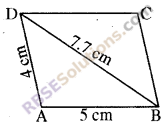
(a) 9 cm and 2 cm
(b) 3 cm and 6 cm
(c) 4 cm and 5 cm
(d) 7 cm and 7.7 cm
Question 8.
Which is not a property of rhombus
(a) all sides equal
(b) diagonals equal
(c) diagonals bisects each other
(d) diagonals are perpendicular to each other
![]()
Question 9.
Number of diagonals in a quadrilateral are
(a) 1
(b) 2
(c) 3
(d) 4
Answers
1. (d)
2. (c)
3. (b)
4. (b)
5. (b)
6. (d)
7. (c)
8. (b)
9. (b).
![]()
II. Fill in the blanks
Question 1.
If the diagonals of a parallelogram are perpendicular to each other than it is a ……..
Question 2.
If the diagonals of a(RBSESolutions.com)quadrilateral bisect each other, then it is a ………
Question 3.
Each angle of rectangle and square is a ……
Question 4.
Opposite sides of a parallelogram are ……
Question 5.
A parallelogram(RBSESolutions.com)with sides of equal length is called ……….
Answer.
1. rhombus
2. parallelogram
3. 90°
4. equal
5. rhombus.
![]()
III. Very Short Answer Type Questions
Question 1.
Write any two necessary conditions for constructing a unique square.
Answer
A quadrilateral can be constructed if
- the length of its four sides and a diagonal is given.
- the two diagonals(RBSESolutions.com)and three sides are known.
Question 2.
Define square.
Answer
A square is a rectangle with equal sides.
Question 3.
If two diagonals are equal in a parallelogram, then which type of quadrilateral is this?
Answer
Rectangle.
![]()
Question 4.
Define rhombus.
Answer
A rhombus is a parallelogram(RBSESolutions.com)with sides of equal length.
Question 5.
Define trapezium.
Answer
Trapezium is a quadrilateral with a pair of parallel sides.
Question 6.
Write the properties of parallelogram.
Answer
- Opposite sides are equal.
- Opposite angles are equal.
- Diagonals(RBSESolutions.com)bisect one another.
Question 7.
Write any two conditions for constructing a unique quadrilateral.
Answer
A quadrilateral can be constructed uniquely
- if the length of its four sides and a diagonal is given,
- if its two adjacent(RBSESolutions.com)sides and three angles are known.
![]()
IV. Short Answer Type Questions— Think, Discuss and Write
Question 1.
Arshad has five measurements
of a quadrilateral ABCD. These are AB = 5 cm, ∠A = 50°, AC = 4 cm, BD = 5 cm and AD = 6 cm. Can he construct a unique quadrilateral? Give reasons for your answer.
Solution
The quadrilateral ABCD with the given data cannot be constructed because of the following reasons :
- If he takes diagonal BD first, then he is able to construct one ∆ABD but the second ABCD to complete the quadrilateral ABCD cannot be drawn(RBSESolutions.com)as its only one side BD is known.
- If he takes the diagonal AC first, then the construction of ∆ACP and ∆ABC is not possible as the data are insufficient.
Question 2.
We saw that 5 measurements of a quadrilateral can determine a quadrilateral uniquely. Do you think any five measurements of the quadrilateral can do this?
Solution
It is necessary to have at least the knowledge of five parts to be able to construct quadrilateral uniquely
- When four sides and one diagonal are given.
- When two diagonals and three sides are given.
- When two adjacent(RBSESolutions.com)sides and three angles are given.
- When three sides and two included angles are given.
- When four sides and one angle are given.
![]()
Question 3.
Can you draw a parallelogram BATS where BA = 5 cm, AT = 6 cm and AS = 6.5 cm? Why?
Solution
Yes, the parallelogram BATS with the given data can be drawn as it can be divided into two triangles BAS and SAT.
Question 4.
Can you draw a rhombus ZEAL where ZE = 3.5 cm, diagonal EL = 5 cm? Why?
Solution
Yes, the rhombus ZEAL with the
given data can be drawn as it can be divided into two triangles ZEL and LEA.
Question 5.
A student attempted to draw a quadrilateral PLAY where PL = 3 cm, LA = 4 cm, AY = 4.5 cm, PY = 2 cm and LY = 6 cm, but could not draw it What is the reason? [Hint : Discuss it using a rough sketch].
Solution
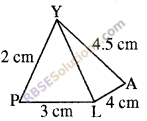
A rough sketch is given here according to given data. We observe that
\(PY+PL\ngtr YL(2+3\ngtr 6)\)
so construction of ∆PLY is not possible. Thus the quadrilateral PLAY cannot be drawn.
Question 6.
Can you construct a(RBSESolutions.com)quadrilateral PQRS with PQ = 3 cm, RS = 3 cm, PS = 7.5 cm, PR = 8 cm and SQ = 4 cm? Justify your answer.
Solution
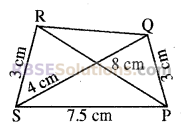
We draw a rough sketch of quadrilateral PQRS. Quadrilateral PQRS cannot be drawn as we cannot draw the ∆QSP since
\(SQ+QP\ngtr SP\)
![]()
Question 7.
Construct a quadrilateral ABCD whose sides are AB = 4 cm, BC = 5 cm, CD = 4.5 cm, ∠B = 60°and ∠C = 90°.
Solution
(i) First of all we draw a rough sketch of the required quadrilateral and write down the given dimensions.
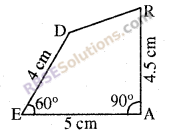
Steps of Construction
1. We draw EA = 5 cm.
2. Then we make ∠XEA = 60°
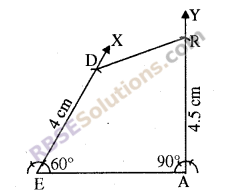
3. With E as centre and radius 4 cm, we cut off ED = 4 cm along EX.
4. Now we make ∠EAY = 90°
5. With A as centre and radius 4.5 cm, we draw an arc to cut off AY at R.
6. At the(RBSESolutions.com)end, we join DR.
Hence DEAR is the required quadrilateral.
Question 8.
Construct the kite EASY if AY = 8 cm, EY = 4 cm and SY = 6 cm (see figure). Which properties of the kite did you use in the process?
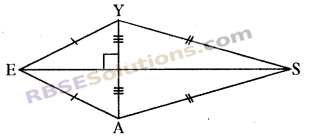
Solution
In the process of construction of the kite, we use the property that a kite has two pairs of equal adjacent sides and unequal sides. We draw a line PQ of any reasonable length. We take any point on it. At L, construction RU ⊥ PQ is shown.
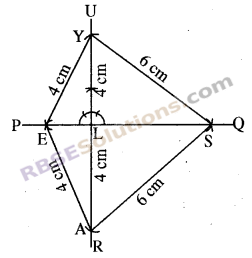
Along LR and LU, cut off LA = LY = 4 cm with A as centre, we draw an arc of radius 4 cm. With Y as centre, we draw(RBSESolutions.com)another arc of radius 4 cm intersecting the(RBSESolutions.com)previous arc at E. We join EA and EY. With A as centre and radius 6 cm, we draw an arc on the other side of RS. With Y as centre, we draw another arc of radius 6 cm intersecting the previous arc at S. Join AS and YS. Thus we obtain the required kite EASY.
![]()
Question 9.
Construct a square ABCD, given that diagonal BD = 5.6 cm.
Solution
First we make a rough diagram for given data.
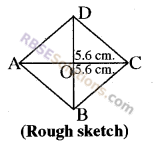
Construction
(i) Draw AC = 5.6 cm.
(ii) Draw a perpendicular bisector of AC and get O.
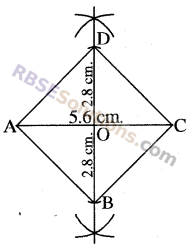
(iii) Draw a arc of 2.8 cm. on this perpendicular(RBSESolutions.com)bisector.
(iv) Join AD, DC, CD and AB. Get the required square ABCD.
Question 10.
Construct a rhombus PQRS whose diagonals are PR = 8 cm and QS = 10 cm.
Solution
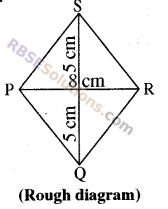
Construction
Step 1. First draw PR = 8 cm.
Step 2. Draw perpendicular bisector of(RBSESolutions.com)diagonal PR, which meets PR at O.
Step 3. Taking O is as centre, an arc OQ = OS = 5 cm is drawn which intersect the perpendicular bisector. Join PQ, QR, RS and PS.
Hence, we get the required rhombus PQRS.
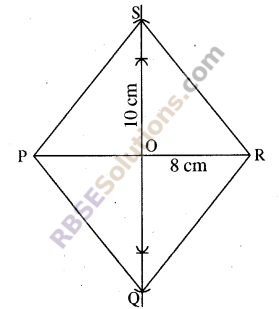
Question 11.
Construct a quadrilateral ABCD whose sides are AB = 4.5 cm, BC = 5.5 cm, CD = 4 cm, AD = 6 cm and diagonal AC = 7 cm. .
Solution
First we draw a rough sketch of quadrilateral ABCD. Draw a diagonal AC and write down its dimension in rough figure.
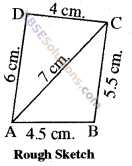
Steps of Construction
(i) First of all, draw a line segment AB = 4.5
cm.
(ii) With B as centre draw an arc of 5.5 cm. and with A draw an arc of 7.0 cm. Write the name C at the intersection point of both arc. Join AC and BC.
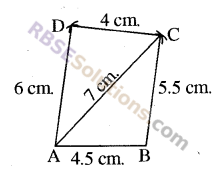
(iii) With A as centre draw an arc of 6 cm and with C as centre draw an arc of 4 cm. Now name point D to the intersect point of both arcs. Join AD and CD. Thus, ABCD is the required quadrilateral.
![]()
Question 12.
Construct a rectangle whose adjacent sides are 6 cm and 4 cm.
Solution
First we draw a rough(RBSESolutions.com)sketch of rectangle ABCD. Write down its dimension in rough figure.
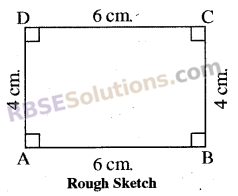
We know that opposite sides of rectangle are equal and each angle is 90°.
Steps of Construction
(i) First draw a line segment AB = 6 cm.
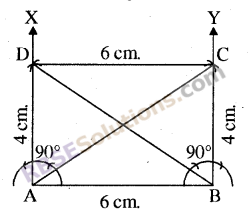
(ii) Draw a ray AX with pencil and compass such that ∠BAX = 90°. Draw an arc of 4 cm with point A which(RBSESolutions.com)intersects AX at D.
(iii) Similarly, draw ray BY such that ∠ABY = 90°. Draw an arc of 4 cm with point B which intersects BY at C.
(iv) Join CD.
Thus ABCD is the required rectangle.
![]()
We hope the given RBSE Solutions for Class 8 Maths Chapter 7 Construction of Quadrilaterals Additional Questions will help you. If you have any query regarding Rajasthan Board RBSE Class 8 Maths Chapter 7 Construction of Quadrilaterals Additional Questions, drop a comment below and we will get back to you at the earliest.